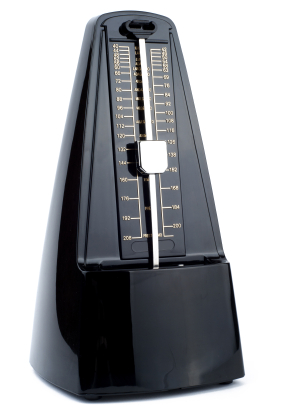What is a Metronome?

The Importance of the Metronome
Learning how to play an instrument can be challenging at times. Learning how to
hold an instrument, making sense of the notes, and keeping tempo, all at the same
time, can require quite a bit of patience and one’s full attention.
Of course, any musician will also tell you that the effort that goes into learning
an instrument is well worth it. Musicians, whether they’re beginners, intermediate
or advanced, should know that a metronome can help them with one of the more challenging
aspects of playing and learning a musical instrument – mastering timing and
tempo.
What is a Metronome?
Metronomes have been used by musicians for centuries, and it’s known that
numerous composers used metronomes, including Beethoven. Basically, a metronome
is a device that keeps regular beats (or ticks) to help the musician keep the beat
or tempo of a song. Metronomes can be adjusted based on tempo, and they come in
a variety of forms. Metronomes can be mechanical, and adjusted manually, but there
are also electronic metronomes and software programs that can turn your computer
or MP3 player into a metronome. You can even download metronome apps to your phone
or tablet. Whether a musician chooses an antique metronome that can sit on top of
a piano, or a compact metronome to carry with him, the function of the device is
always the same.
There are numerous advantages to using a metronome. Metronomes measure beats per
minute and can assist musicians as a practice tool, to learn beats and tempos, and
to develop a sense of rhythm. In addition, metronomes help prevent music students
from practicing the wrong way. Many musicians, especially beginning musicians, tend
to concentrate on notes, and playing them correctly. Often times, the beat or tempo
takes a back seat or is less of a priority. Metronomes help students practice a
musical piece correctly, so that they learn correctly from the beginning, and avoid
repeating or “learning” mistakes. In addition, metronomes can minimize
frustration when a student slows a beat down to a practical pace, and then resets
the metronome once the piece is mastered.
By establishing a tempo for the musician, a metronome can also help the student
through difficult passages, keeping the student from slowing down and losing the
beat, or from speeding up to get through a difficult patch.
Metronomes can also assist when multiple musicians collaborate on a piece, serving
as a conductor of sorts, and keeping the musicians together, playing cohesively.
Educators and parents also use metronomes to assist children with learning differences,
such as ADD or ADHD or to assist seniors in order to help them develop a sense of
rhythm and timing, or improve brain function and concentration.
Finally, a metronome is helpful in keeping students focused and on the project at
hand. It takes a lot of concentration to keep up with the ticks, or beats of the
metronome, and that’s one reason music teachers are likely to introduce their
students to the device. Many teachers believe metronomes can aid a student’s
musical development and improve concentration while enhancing the musical experience.

